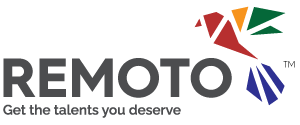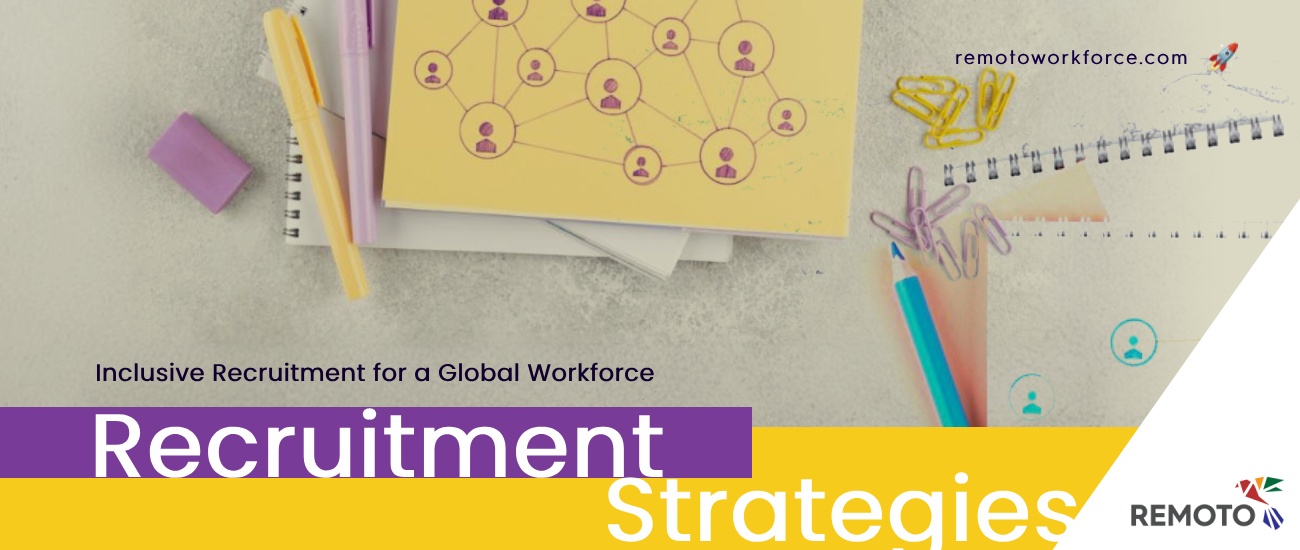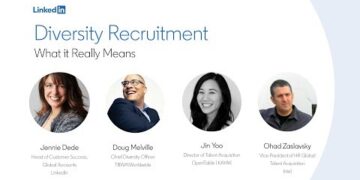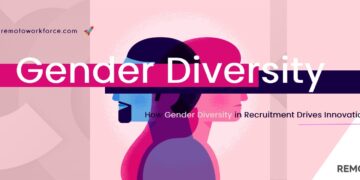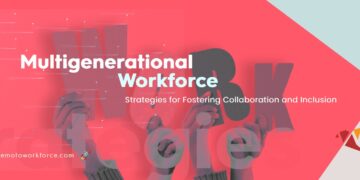Diversity and inclusion are vital components of a thriving business. Companies that hire people from all backgrounds create a workplace where everyone feels important. This helps them innovate more, keep employees longer, and have a better brand image.
But what does it take to build an inclusive recruitment strategy that attracts a global workforce?
In this post, we’ll address actionable strategies that help companies foster a more inclusive recruitment approach. By following these practices, your business can create a workforce that reflects the world’s diverse culture. This will create workplaces that are lively, creative, and ready for success.
So, let’s get started!
Step One: Define Diversity, Equity, and Inclusion in Your Own Words
Defining diversity, equity, and inclusion (DEI) is the first step in creating a recruitment strategy that really welcomes all candidates.
Each company’s approach to DEI will be unique because diversity recruitment encompasses a wide range of factors beyond just gender or race. For some companies, diversity may mean actively recruiting neurodiverse talent, veterans, or people from different generational backgrounds.
It could also mean recognizing intersectionality or assuming that people experience diversity differently based on a blend of factors, like a Black woman’s experience differing from a White woman, even if they hold similar roles.
This definition should be more than a statement on paper; it must be embedded in your company’s culture.
What values drive your approach to hiring? Which groups are currently underrepresented?
Start by having open conversations with team members across all levels, gathering their perspectives on what diversity means to them. Employees are your best advocates: They know the company’s culture inside and out and can provide insights that shape a meaningful DEI definition.
Once you have a clear picture, integrate your definition of DEI into your brand messaging. Use language that reflects your commitment in all communications, from job ads to your website. A clear DEI vision lets you set goals and make your team responsible. This makes sure that your recruitment process is planned and effective.
Step Two: Craft Job Descriptions That Speak to Everyone
Job descriptions are often the first impression candidates have of your company, so it’s essential to make them inclusive. Job ads often reflect unintentional language that may dissuade specific demographics from applying.
For example, terms like “competitive” and “assertive” may feel masculine and could discourage female applicants. Also, technical jargon might alienate candidates from different fields but could still bring valuable skills to the role.
To create a more inclusive job description, start with the basics. Use clear, gender-neutral language, and focus on skills over credentials where possible. For example, instead of requiring a degree in a particular field, emphasize the competencies or experience level needed.
Highlight essential job responsibilities over rigid qualifications, and avoid phrases that suggest only specific types of applicants are welcome. Simplify your text with short sentences and bullet points to ensure readability for those with dyslexia or visual impairments.
It’s also helpful to emphasize your company’s DEI commitment in every job ad. Include statements about your inclusive culture and the support structures in place for employees. By showing potential applicants that they will be in a friendly place, you’ll get more people who want to apply.
Step Three: Build an Accessible and Inviting Careers Page
Your careers page is a valuable tool for conveying your company’s inclusivity to prospective applicants.
Make sure that it’s designed with accessibility in mind and clearly communicates your commitment to diversity. This includes using language that speaks to all backgrounds, avoiding stock photos in favor of authentic images, and ensuring the page meets Web Content Accessibility Guidelines (WCAG) for usability.
Accessible websites help everyone, especially job seekers with disabilities. Make sure your website has text that describes images, videos with captions, and an easy-to-use layout. A simple, logical design with easy navigation and high-contrast colors makes the site more welcoming to people with visual or thinking problems.
Also, take the opportunity to share stories of your team members’ diverse backgrounds and experiences on your careers page. When potential candidates see people like themselves thriving in your company, it reinforces that your organization values diversity and inclusion in a tangible, meaningful way.
Step Four: Broaden Your Job Posting Platforms
Where you post job openings can greatly impact the diversity of your applicant pool. Relying solely on traditional job boards may limit your reach, as different demographics often gravitate toward unique platforms.
Social media is also a valuable tool for expanding your recruitment reach. Consider using platforms like LinkedIn and Twitter, where you can directly connect with diverse communities and showcase your inclusive brand values. Hosting webinars or participating in job fairs and networking events tailored to diverse groups are additional ways to reach a broader audience.
By strategically broadening your recruitment channels, you’ll attract applicants who bring varied perspectives, skills, and experiences to your organization. This diversity not only enriches your team but also gives your company a competitive edge in a global market.
Step Five: Implement Structured Interviews to Mitigate Bias
Bias can creep into the recruitment process at any stage, but one of the most effective ways to minimize it is through structured interviews.
In a structured interview, every candidate is asked the same set of predetermined questions, ensuring a fair comparison based on job-related criteria alone. This reduces the risk of unconscious bias and enables hiring managers to make more objective decisions.
Consider implementing a scorecard that assigns each candidate a rating based on their responses to job-specific questions.
This helps keep evaluations focused on the skills and competencies needed for the role, rather than personal characteristics or perceived similarities to existing team members. Avoid questions related to salary history, as they can reinforce systemic pay inequities.
Another best practice is to have a diverse panel of interviewers. By including individuals from different backgrounds and departments, you create a more balanced view of each candidate. A diverse panel can assess qualities that may otherwise be overlooked and provide candidates with a sense of your company’s inclusive culture.
Step Six: Leverage Technology While Monitoring for Algorithm Bias
Technology offers powerful tools to make recruitment more efficient and objective, but it’s essential to be careful of algorithmic biases. Applicant tracking systems (ATS) and job description analysis tools can help make hiring easier. But if you don’t watch carefully, they may accidentally favor certain groups based on past data.
Choose ATS platforms with functionalities that reduce bias, such as anonymous resume screening and demographic tracking. Some systems even include options to conduct blind CV reviews, where information like gender and age are hidden from hiring managers. However,
Step Seven: Track Your Progress with Inclusive Hiring Metrics
Measuring the success of your inclusive hiring practices is crucial to ensure your strategies are effective. Metrics help you see which parts of your hiring process need to be improved and where you’re making significant progress in diversity and inclusion.
Consider tracking demographics across different stages of the recruitment funnel.
For instance, monitor the diversity of applicants versus hires and pay attention to the retention rates of employees from underrepresented groups. Employee Net Promoter Scores (eNPS) can also provide insight into the experience and satisfaction of diverse team members within your organization.
Establish clear, data-driven goals, such as increasing minority representation in leadership positions or achieving a certain percentage of female employees across departments. Regularly evaluate your progress and refine your hiring practices as needed. Inclusive hiring is an ongoing process, and metrics help keep your company accountable and aligned with its D&I objectives.
Step Eight: Cultivate a Culture of Belonging Beyond Hiring
Creating an inclusive workforce goes beyond recruitment; it requires fostering a culture of belonging that ensures everyone feels valued and supported. An inclusive culture means employees from all backgrounds can thrive, contribute, and advance within the organization.
Consider offering mentorship and sponsorship programs to support the career growth of underrepresented groups.
This not only helps with retention but also creates a supportive network where employees can learn from each other’s experiences. Encourage open conversations around diversity and regularly check in with team members to ensure they feel seen and heard.
Furthermore, celebrate diversity through cultural events, workshops, and learning opportunities.
Create space for employees to share their unique experiences and perspectives, which can help build understanding and appreciation across your workforce. A culture that embraces and celebrates diversity ultimately strengthens your team and supports the long-term success of your business.
Takeaway
Incorporating diversity into hiring goes beyond being a mere guideline. It entails a dedication to establishing an environment where every opinion is listened to, appreciated, and esteemed.
By implementing these methods, you are not only recruiting staff members but constructing a multicultural staff that mirrors the diversity of human beings.
When diversity and inclusion are central to your hiring procedures, you establish the groundwork for a more robust, inventive, and empathetic organization.
